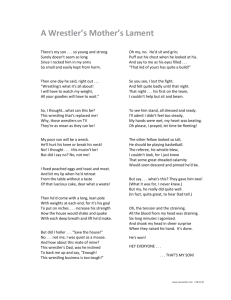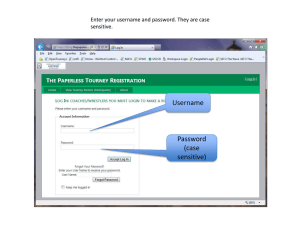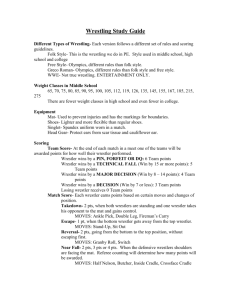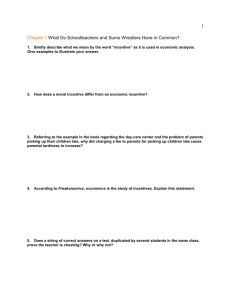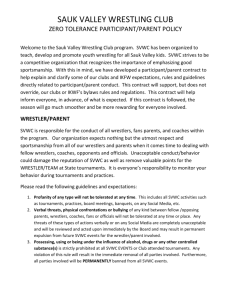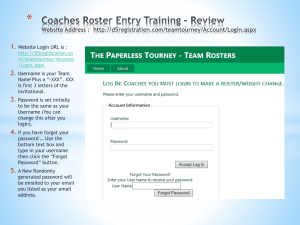Overview of Wrestling Rules
advertisement
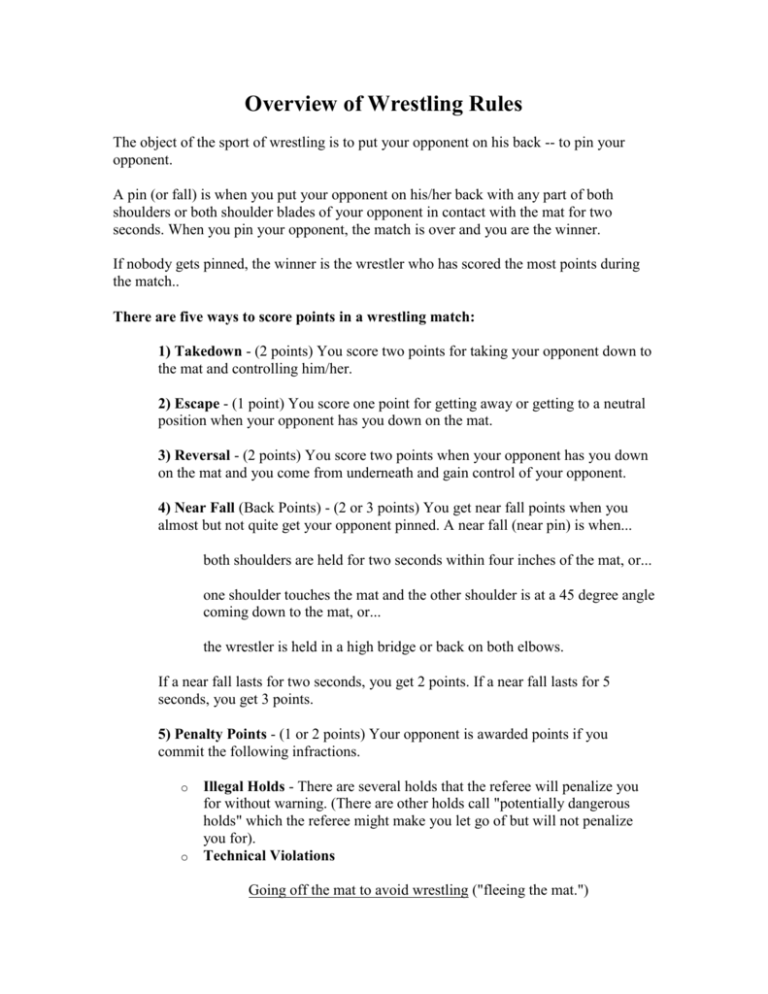
Overview of Wrestling Rules The object of the sport of wrestling is to put your opponent on his back -- to pin your opponent. A pin (or fall) is when you put your opponent on his/her back with any part of both shoulders or both shoulder blades of your opponent in contact with the mat for two seconds. When you pin your opponent, the match is over and you are the winner. If nobody gets pinned, the winner is the wrestler who has scored the most points during the match.. There are five ways to score points in a wrestling match: 1) Takedown - (2 points) You score two points for taking your opponent down to the mat and controlling him/her. 2) Escape - (1 point) You score one point for getting away or getting to a neutral position when your opponent has you down on the mat. 3) Reversal - (2 points) You score two points when your opponent has you down on the mat and you come from underneath and gain control of your opponent. 4) Near Fall (Back Points) - (2 or 3 points) You get near fall points when you almost but not quite get your opponent pinned. A near fall (near pin) is when... both shoulders are held for two seconds within four inches of the mat, or... one shoulder touches the mat and the other shoulder is at a 45 degree angle coming down to the mat, or... the wrestler is held in a high bridge or back on both elbows. If a near fall lasts for two seconds, you get 2 points. If a near fall lasts for 5 seconds, you get 3 points. 5) Penalty Points - (1 or 2 points) Your opponent is awarded points if you commit the following infractions. o o Illegal Holds - There are several holds that the referee will penalize you for without warning. (There are other holds call "potentially dangerous holds" which the referee might make you let go of but will not penalize you for). Technical Violations Going off the mat to avoid wrestling ("fleeing the mat.") Grabbing clothing, the mat, or the headgear Incorrect starting position or false start (You get two cautions before points are awarded). Locked or overlapped hands: If you are down on the mat in control of your opponent, you cannot lock or overlap your hands, fingers or arms around your opponent's body or both legs unless you have your opponent in a near pin, or your opponent stands up and has all his/her weight on two feet. Leaving the mat during the match without the referee's permission Figure 4 head scissors from the neutral position. o o o o Unnecessary roughness Unsportsmanlike conduct Flagrant Misconduct (ejection, the match is over) Stalling (you get one warning before you are penalized and points are awarded). The first and second time you are penalized, your opponent is awarded one point. The third time you are penalized, your opponent is awarded two points. The fourth time you are penalized, you are disqualified. (Except for illegal starting position or false start - you are cautioned twice, then one point awarded for each infraction, but you will not be disqualified). These rules apply to the type of wrestling done in the United States in College, High School, Junior High, Middle School, and most youth wrestling. This type of wrestling is often referred to as "folkstyle" wrestling. The rules for "freestyle" and "greco-roman" wrestling, as is done in the olympics and internationally, are a little different. Dual Meet Team Scoring Fall, Forfeit, Default, Disqualification - 6 team points Technical Fall (getting ahead of your opponent by 15 points ends the match) - 5 team points Major Decision (winning the match by 8 - 14 points) - 4 team points Decision (winning the match by fewer than 8 points) - 3 team points Tournaments Tournament Scoring 2 team advancement points shall be scored for each match won in the champoinship bracket, except for the final first-place match. If a wrestler receives a bye in the first round, he shall be awarded 2 advancement points for that round if he wins his next match. 1 team advancement point shall be scored for each match won in the consolation elimination, except for the final third and fifth place matches. A wrestler who has received a bye in the consolation round shall receive one advancement point, provided he wins his next round match. 2 additonal points for each match won by default, disqualification, fall, or forfeit. 1 1/2 points for each match won by technical fall. 1 additional point for each match won by maor decision. Placement points: Tournament scoring 4 places: 14-10-7-4 Tournament scoring 6 places: 16-12-9-7-5-3 Tournament scoring 8 places: 16-12-9-7-5-3-2-1 Individual placement points shall be awarded as soon as earned. Placement points already earned shall be deducted in case of forfeit (other than injury) or disqualification from the tournament. In view of the rule requiring placement points to be added as soon as earned, placement points are added at the following junctures in a tournament scoring 6 places: Championship quarterfinal winners: Add 3 points (has earned at least 6th place) Championship semifinal winners: Add 9 points (has earned at least 2nd place, already received 3 points) Championship final winners: Add 4 points Consolation quarterfinal winners: Add 3 points (has earned at least 6th place) Consolation semifinal winners: Add 4 points (has earned at least 4th place, already received 3 points) Consolation final winners (for third): Add 2 points Winner of final for 5-6: Add 2 points National Federation Official High School Wrestling Rule Books are published by: National Federation of State High Schools Association P. O. Box 690 Indianapolis, Indiana 46206 Phone: (317) 922-6900 Fax: (317) 822-5700 WRESTLING RULES, SCORING CRITERIA, AND MORE By Bill Welker, Ed.D. The following are many of the more specific rules (labeled as items) that are part of the sport of wrestling. Also questions after each item to test your understanding. Item 1: THE TAKEDOWN The objective of wrestling is to pin your opponent, but it usually involves a takdown to accomplish this goal. As a matter of fact, it has been proven statistically that the wrestler who executes the first takedown in a match will win the match 85 to 90% of the time. What is considered a takedown? Well, to set up a takedown, the wrestlers must be working from the neutral or standing position; a situation where neither wrestler has control. Then a takedown is scored when one of the wrestlers gains control over the other, causing his opponent's supporting points (the area or areas in which most of the body weight is placed) to be the knees, thighs, buttocks, or hands. In reference to out-of-bounds situations, a wrestler can be awarded a takedown as long as he or his adversary is in-bounds. Remember, the line around the mat is out-of-bounds. And don't forget, a takedown can be awarded if the scoring wrestler's feet are in-bounds and touching the mat. In years past, the scoring wrestler's knees had to be in-bounds. When the takedown is a achieved, the offensive man receives two match points. The double-leg drop, single-leg sweep, fireman's carry, arm drag, snap down and pancake are just a few types of takedowns. Q: Wrestler A shoots a double leg takedown on Wrestler B. At the completion of the takedown, Wrestler B is completely out of out-of-bounds and Wrestler A's feet are inbounds. Would a takedown be awarded? A: Since the feet of Wrestler A were in-bounds, the takedown would be awarded. Item 2: ESCAPES AND REVERSALS The wrestler in control or on top is referred to as the offensive wrestler, while the wrestler on the bottom is the defensive matman. Keep in mind, only the defensive man can score an escape or reversal. THE ESCAPE: For the bottom man to secure an escape, he must place himself in the neutral position, causing his opponent to lose control. The defensive wrestler may also be awarded an escape going out-of-bounds if his adversary is in-bounds at the completion of the move. The official will indicate one point for the wrestler who earns an escape. The stand-up, forward or Granby roll, sit-out turn-in, and sit-out turn-out are examples of escape maneuvers. THE REVERSAL: The defensive wrestler may procure a reversal by moving from the bottom position to the top position, gaining control of his opponent either on the mat or on their feet. Like the escape, a reversal can be obtained crossing the out-of-bounds line if one of the wrestlers is in-bounds. The referee will designate two points for a reversal. The switch, side roll and Peterson roll are examples of reversals. Remember, one match point is awarded for an escape and two match points are given for a reversal. Q: The bottom man stands up and hits a standing switch, spinning behind and controlling his opponent while on their feet. Would a reversal be awarded? A: The referee would award a two-point reversal because he gained control of his opponent on their feet. Note: If it were a takedown move, however, the wrestler must be brought down to the mat for points to be scored. Item 3: THE NEAR FALL Only the offensive (or top) wrestler can score a near fall. He may do so by causing the defensive wrestler... (1) to spring into a high bridge, (2) to lean back on his elbows, (3) to expose his shoulders four inches or less to the mat, and (4) to have one shoulder on the mat and the other 45 degrees or less above the mat. The top wrestler can score two points by holding (for two seconds) the bottom wrestler in any of the above noted positions. Furthermore, if the offensive wrestler can secure a near fall for a continuous five-second period, he would then be awarded three match points for the maneuver. Note, the official usually indicates a near-fall situation with an angular sweep of the arm, each sweep designating a second, but he will not signal any points until the near-fall hold is terminated. In reference to the out-of-bounds line, if both shoulders are partially in-bounds and one shoulder is completely in-bounds, a near fall can be scored. The half-nelson, cradle, three-quarter nelson, and arm bar series are near-fall maneuvers that can ultimately lead to a "fall." Q: Wrestler A, using a half-nelson, forced Wrestler B to bridge high on his head for four seconds. Then Wrestler B turned to his stomach, only to be placed in another near-fall situation when Wrestler A cradled him. He was held there for another five seconds when the period ended. How many near-fall points did Wrestler A receive, altogether? A: Wrestler A would receive a total of five match points: two points for the first near-fall situation and three points for the second. Item 4: THE FALL The fall (or pin) terminates the match and no individual match points are necessary. Of course, the winner's squad receives six team points. Now a fall occurs when both shoulders are forced to the mat for a period of two seconds in high school and only one second in college. The official mentally counts this time and indicates the fall by slapping the mat. Normally, the offensive wrestler (the man in control) scores the fall. However, if the offensive grappler's shoulders are somehow placed on the mat for the required time, a fall is awarded to the defensive wrestler. Finally, in reference to the out-of-bounds line, if the shoulders are partially in-bounds or one shoulder is completely in-bounds, a fall may be called. Q: Wrestler A, the offensive wrestler, cradles Wrestler B and takes him to his back. However, when finishing this move, Wrestler A ends up completely out-of-bounds and only the top of Wrestler B's shoulders are in-bounds on the mat. What's the call? A: If Wrestler B was held in the aforementioned position for the required amount of time, a fall would be called. Since the top of the shoulders are in-bounds, wrestling would continue. Item 5: ILLEGAL HOLDS The best definition for an illegal hold would be "any maneuver used that could cause bodily harm intentionally or not." Examples of illegal moves include full nelsons, over scissors, back bows, headlocks (without an arm encircled), forceful trips, pulling a thumb or less than four fingers, holds that restrict breathing or circulation, and any holds used for punishment alone. Illegal maneuvers are penalized in the following manner: first and second offense - one match point for opponent; third offense - two match points for opponent; and fourth offense - disqualification from the match. Note, a wrestler applying a legal hold shall not be penalized if his adversary turns it into an illegal hold. And whenever possible, an illegal move should be prevented by the official rather than penalized. Q: Wrestler A applies an illegal full nelson to Wrestler B just prior to the final buzzer of the last period. It was Wrestler A's fourth illegal hold of the match. The score prior to this offense was 12-5 in favor of Wrestler A. What is the penalty for this offense and the outcome of the match? A: Wrestler A would be disqualified and Wrestler B is the winner. Item 6: UNNECESSARY ROUGHNESS Any intentional act that is hazardous to an opponent's physical well-being is considered unnecessary roughness. Furthermore, if a hold is utilized for the sole purpose of punishment alone, the referee may see fit to declare unnecessary roughness. Such perpetrations as striking, kicking, butting with the head, elbowing, and forceful tripping are examples of this infraction. Normally, the violator would be penalized as follows: first offense - one point; second offense - another point for his rival; third offense - two points for his adversary; and fourth offense - disqualification. However, when the official believes the unnecessary roughness of the wrestler to be totally inexcusable, he can indicate a "flagrant misconduct" signal, which is an automatic disqualification and the deduction of ALL team points scored in the event. Certainly, a sucker punch to the jaw would fall under this category. Q: Wrestler A shoots a hard double leg, causing Wrestler B to hit his head on the mat forcefully when taken down. The match had to be stopped to check if Wrestler B was injured. Would this be considered unnecessary roughness on the part of Wrestler A? A: Wrestler A would not be penalized with unnecessary roughness. It was a legal move similar to a hard tackle in football. Item 7: TECHNICAL VIOLATIONS There are six technical violations in wrestling and all but one are penalized in the following manner: First Offense - 1 penalty point (for opponent); Second Offense - 1 penalty point; Third Offense - 2 penalty points; Fourth Offense - Disqualification. Let's now consider wrestling's six technical violations: "Leaving the Mat Proper" -- No wrestler may completely step off the wrestling mat without permission of the referee. "Intentionally Going Out-Of-Bounds" -- If either wrestler goes out-of-bounds to avoid wrestling his opponent for any reason (except when near-fall points are scored), this technical violation will be enforced. "Grasping of Clothing" -- A contestant may grab nothing but his opponent while wrestling or this encroachment will be called. Furthermore, when a wrestler grasps his adversary's uniform to prevent him from scoring, the appropriate penalty point(s) will be given along with any points his opponent may have obtained. "Interlocking or Overlapping Hands" -- The offensive (or top) wrestler may only lock or touch hands around his opponent's body or both legs when he is scoring near-fall points or his antagonist stands up. If his rival scores points while he commits this violation, his opponent would also receive the stipulated penalty point(s). Note, the official can only stop the match to award point(s) when the bottom man is unable to gain an escape or reversal due to interlocking or overlapping hands. "Incorrect Starting Position" -- If a wrestler assumes an incorrect neutral or referee's position (Remember, this year wrestlers would be "corrected" two times.), a technical violation would be called. This also includes false starts in both situations. Note, unlike other technical violations, the first two offenses are "cautioned" (The official will form a "C" with his hand.), and then penalized if the infraction occurs again. Furthermore, this technical violation is not on the "progressive penalty chart." Thus, a wrestler can not be disqualified for an incorrect starting position or false start. "The Figure-4 Head Scissors" -- The figure-4 head scissors is a technical violation in the neutral position. Q: Wrestler A places Wrestler B on his back in a high bridge for three seconds. Wrestler B scoots on his feet and head out-of-bounds on purpose. Is this a technical violation? A: Wrestler B has not committed a technical violation because Wrestler A would have been awarded two match points for a near fall. Item 8: UNSPORTSMANLIKE BEHAVIOR OF WRESTLERS The unsportsmanlike rule for contestants covers two situations in which the penalty is administered differently. They are as follows: Situation One -- If the wrestler is unsportsmanlike during the bout, his opponent would be awarded match point(s) in the following manner: First Offense - 1 point; Second Offense - 1 point; Third Offense - 2 points; Fourth Offense - Disqualification from the match. Situation Two -- If an unsportsmanlike act occurs prior to the first period or after the third period (or fall), the offending wrestler's squad would lose one team point. On the second offense, he would be asked to leave the premises and his squad would lose another team point. (Note: Flagrant misconduct at any time would result in immediate disqualification from the dual meet or tournament and the deduction of ALL team points earned.) Q: During the second period, Wrestler A showed overt displeasure over the referee's call. Is this unsportsmanlike behavior? If so, what is the penalty? A: I would be unsportsmanlike behavior and the official would award Wrestler B one match point since it occurred during the bout. Item 9: UNSPORTSMANLIKE CONDUCT OF COACHES AND SPECTATORS The Coaches -- No coach can be disrespectful during competition. If such were the case, the official would deduct one point from the violator's team. On the second offense, the perpetrator would be removed from the premises for the duration of the dual meet or tournament session. Take note. When a coach's initial action is "flagrant" in nature, he would be expelled immediately (with the loss of two team points) for the duration of the dual meet or the tournament. The Spectators -- No fan may react in an unsportsmanlike manner toward the referee or the opposing coach or wrestlers. This unbecoming response can result in removal from the gym, field house or arena on the official's comment. Important point, neither team would be penalized for misconduct of an over-zealous spectator, and it is up to the home management to remove the offender. Q: During the progress of a dual meet, the referee was constantly being harassed by a heckler in the front row of the home-school's bleachers. Unable to put up with this behavior any longer, the official stopped the match and had the athletic director escort the perpetrator from the gym. The visiting coach immediately demanded that one team point be deducted from the home squad. Was he right or wrong? A: The visiting coach was wrong. Whenever a spectator is removed from the premises for unsportsmanship behavior, no point is deducted from his or her favorite team's score. Item 10: THE ASSISTANT REFEREE An assistant referee may be utilized during competition, usually during tournament action. He is allowed the same mobility around the mat as the referee. Furthermore, the assistant referee can talk to the main official as the match is in progress and help in making calls. He can also signal locked hands and the grasping of clothes technical violations. However, all other calls must be made by the main official. If there is a disagreement between the two, the main official has the final say in the matter. Note, coaches are not permitted to address the assistant referee while the match is being contested. Q: In the second period of the bout, the assistant referee warned Wrestler A for stalling. Immediately, Wrestler A's coach approached the scorer's table and argued that the assistant referee had no authority to make the call. Was he right or out-of-order? A: The coach was correct. Only the main official of the match is allowed to designate stalling Item 11: OFFICIAL'S JUDGMENT CALLS If a referee misapplies a rule, say giving three points for a takedown instead of two, the coach may certainly confront him regarding the matter. However, the coach can not question any judgment calls made by the official. When he does, the referee will first warn him for misconduct, the second offense will cost the coach a team point, and with the third offense, the coach will be asked to leave premises for the duration of the dual meet or tournament session and another team point would be deducted. Q: The referee indicated a takedown at the edge of the mat and then blew the whistle for out-of-bounds. The coach, whose wrestler was taken down, approached the score table to argue with the official over the call. The referee indicated misconduct on the coach's part. Was he right or wrong? A: The referee was right. A coach can not question the judgment of an official. Item 12: THE LOWERING OF SHOULDER STRAPS The lowering of shoulder straps while on the mat is considered an act of unsportsmanlike conduct. The only time it would not be penalized is if the wrestler received permission from the official to do so. Should this infraction occur before wrestling has started or after the completion of wrestling, it would be a deduction of one team-point from the offender's squad. However, if the offense takes place during the match, the violator's opponent would receive a match point. Note, there is a variation of the rule in West Virginia. The unauthorized lowering of shoulder straps anywhere in the gym during competition is considered unsportsmanlike. Q: Wrestler A lowers his shoulder straps between the second and third periods of a match. How would he or his team be penalized? A: Wrestler A's opponent would receive one match point. There would be no team-point deduction since wrestling has not concluded yet. Item 13: SUDDEN DEATH IN DUAL MEETS AND TOURNAMENTS No longer will there be ties or draws for individual matches. Instead, the "Sudden Death" or tie-breaker will be utilized to determine the winner. The new procedure is as follows. During tournament and dual meet action, when the wrestlers are tied at the end of the three regular periods, they will then wrestle an overtime period which will be one minute in length with no rest between the regular match and the overtime. The overtime period will begin with both matmen in the neutral position. The wrestler who scores the first point(s) will be declared the winner. If no winner is determined by the end of the one minute overtime period, a 30-second tiebreaker in the referee's position will be wrestled. The wrestler who scored the first points in the match will have the choice of top or bottom positions, or he may elect to defer the choice to his opponent. The wrestler who scores the first point(s) in this 30-second tie-breaker will be declared the winner. However, if no scoring occurs during this time, the top wrestler will be declared the winner. Note, the sudden death match (overtime and tie-breaker periods) is regarded as an extension of the regular match. All points, penalties, cautions, warnings, and injury time will accumulate throughout the regular match and the sudden death. Finally, there are two other important points. If both wrestlers are penalized the same number of points simultaneously in the overtime period, they immediately proceed to the 30-second tie-breaker. Also, if the points earned in the sudden death involve a takedown or reversal straight to the back, the match shall continue until the near-fall situation has concluded, a fall occurs, or time rans out. I, personally, I think it's great. This further helps to put the outcome of the match in the hands of the wrestlers, not the referee. Q: The regulation match ends in a tie and goes to "sudden death." Thirty seconds into the overtime period both wrestlers are warned for stalling at the same time. What should the referee now do? A: The referee would do nothing. Wrestling would continue in the overtime period until one wrestler scores. Keep in mind, only when both wrestlers are penalized the same number of point(s) would the participants move immediately to the 30-second tie-breaker. Item 14: TEAM SCORING IN DUAL MEETS The chart for team scoring during dual meets is as follows: Dual Meet Team-Scoring Chart Regular Decision -- 3 team points Major Decision -- 4 team points (8-14 point spread) Technical Fall -- 5 team points (15-point spread) Fall, Forfeit, Default, & Disqualification -- 6 team points Remember, this is team scoring during dual meets, not tournaments, which will be next week's topic of discussion. Q: Wrestler A won his match 17-7. How many team points would he score for his squad and what type of win would this be? A: Wrestler A would score 4 team points for his squad with a "Major Decision." Item 15: TEAM SCORING IN TOURNAMENT COMPETITION Below is the team scoring chart in tournaments this year: Tournament Team Scoring Chart Advancement Points: Championship Bracket - 2 points (Regular Decision) Consolation Bracket - 1 point (Regular Decision) Major Decision: 1 point Technical Fall: 1 1/2 points Fall, Default, Forfeit, & Disqualification: 2 points Bye followed by a win: Championship Bracket - 2 points Consolation Bracket - 1 point Tournaments with Four Places: First Place - 14 points; Second Place - 10 points; Third Place - 7 points; Fourth Place - 4 points. Tournaments with Six Places: First Place - 16 points; Second Place - 12 points; Third Place - 9 points; Fourth Place - 7 points; Fifth Place - 5 points; Sixth Place - 3 points. Tournaments with Eight Places: The first six places are the same with 2 points for Seventh Place and 1 point for Eighth place. There are no ties in tournament (or dual meet) competition and the wrestlers must go into overtime to decide the winner, by the overtime "sudden death" procedure. And that fans is team scoring in tournaments. As you can plainly see, the official scorer at wrestling tournaments has his hands full. Q: Wrestler A wins by a score of 22-7 in the consolation bracket. How many points does he score for his team? A: Wrestler A would score 2 1/2 points for his team - 1 point for advancement and 1 1/2 points for a technical fall.
